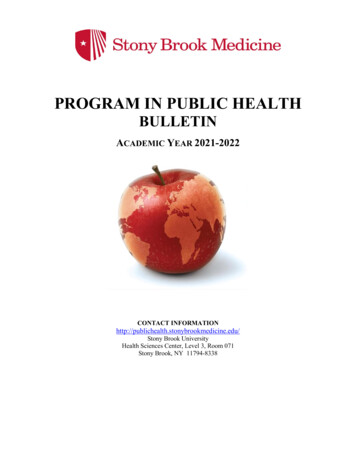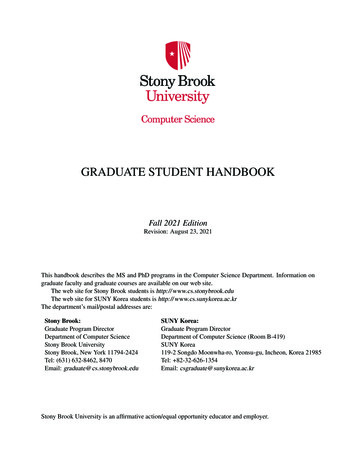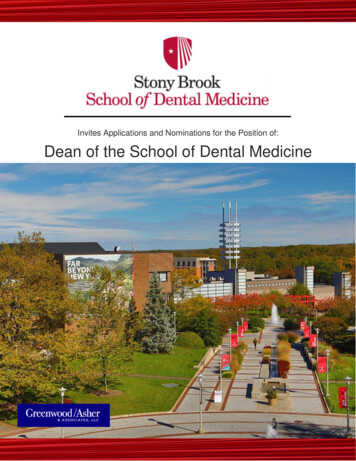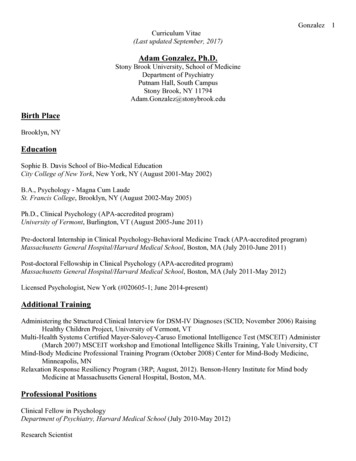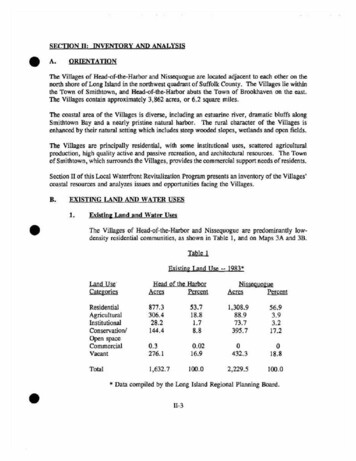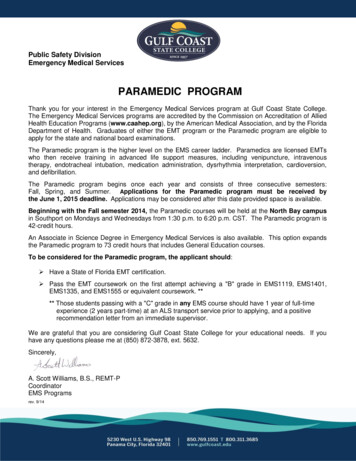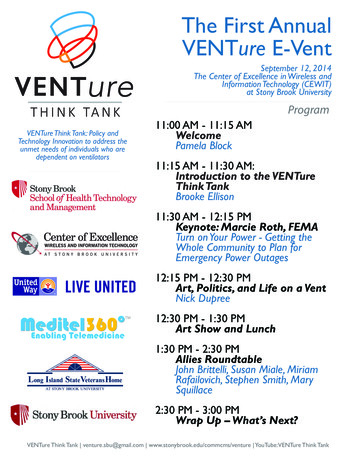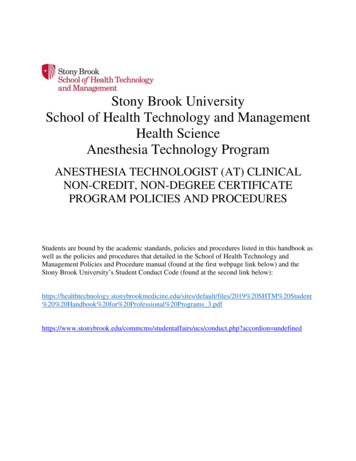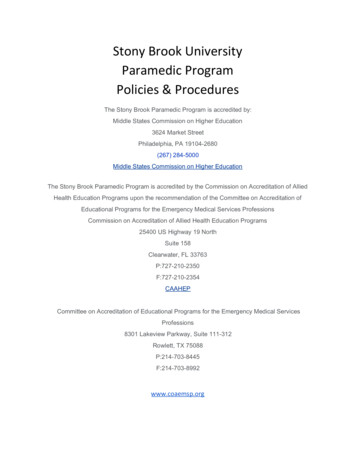
Transcription
Stony Brook UniversityParamedic ProgramPolicies & ProceduresThe Stony Brook Paramedic Program is accredited by:Middle States Commission on Higher Education3624 Market StreetPhiladelphia, PA 19104-2680(267) 284-5000Middle States Commission on Higher EducationThe Stony Brook Paramedic Program is accredited by the Commission on Accreditation of AlliedHealth Education Programs upon the recommendation of the Committee on Accreditation ofEducational Programs for the Emergency Medical Services ProfessionsCommission on Accreditation of Allied Health Education Programs25400 US Highway 19 NorthSuite 158Clearwater, FL 33763P:727-210-2350F:727-210-2354CAAHEPCommittee on Accreditation of Educational Programs for the Emergency Medical ServicesProfessions8301 Lakeview Parkway, Suite 111-312Rowlett, TX 75088P:214-703-8445F:214-703-8992www.coaemsp.org
ContentsFunctional Job Analysis - ParamedicAdmission PolicyAdvanced PlacementCredit for Experiential LearningAmericans with Disabilities ActAcademic IntegrityCritical Incident ManagementWithdrawals, and RefundsCommunicationComputer Access Requirement & UseCell Phones in ClassPhysical ExaminationProfessional Liability InsuranceDrug TestingExtra Help / Office HoursHand WashingConfidentiality IssuesUnethical BehaviorUniform / Dress Code DescriptionMinimum Course RequirementsAcademic Standards & Practical Lab SkillsExaminations (Summative Assessment)Quizzes (Formative Assessment)Quiz Review (formative only)Rescore RequestFinal Comprehensive ExaminationWritten Test Taking ConductPractical SkillsPractical Skills Test Taking ConductClinical Rotations (Hours & Competences)Rotation Drop Request ProcedureRotation Evaluation FormAttendance Verification System AVS (Field and Clinical Rotations)Hospital Break TimesService Work While Enrolled in the ProgramProfessionalism & AttendanceProfessionalism ScoreAttendance
Introduction & General Policies :In addition to the course website, The Policies and Procedures provide the framework for the orderlyconduct of the paramedic program. They are intended to ensure a thorough and complete education foreach of the students. It is the responsibility of the student to know and satisfy the programrequirements. Please also reference the following important School of Health Technology andManagement documents. They are available through the course website. If there is any overlapping orcontradictory information between this Paramedic Program Handbook and any of the above documentsthis Paramedic Program Handbook takes precedence. Letter from the Dean to all new SHTM Students SHTM Mission Statement Student Handbook Table of Contents Student Orientation Handbook Academic Standing Academic Standing - Grading Academic Policies - Dishonesty Clinical Practicum - Student Responsibility Non-Discrimination Policy Sexual Harassment PolicyFunctional Job Analysis - ParamedicFor a functional job analysis as described by the New York State Department of Health click HEREAdmission PolicyThe Paramedic Program will not discriminate in its admission policies on the basis of sex, race, nationalorigin, religion, or sexual preference.Admission is based on a personal interview with the program staff or staff member.At a minimum all candidates must: Hold a high school diploma or equivalent and; Be a currently certified New York State EMT or AEMT and; Be a nationally registered EMT and be eligible for NYS EMT certificationNote: At the discretion of the program director, applicants who have completed an EMT program andare awaiting results may be provisionally admitted into the program. Students are responsible tomaintain a valid New York State (A)EMT certification for the duration of the course.Advanced PlacementThe Stony Brook University Paramedic Program currently only accepts advanced placement petitionsfrom prior students of the Stony Brook Program.
Credit for Experiential LearningApplicants to the program with professional credentials (RN, PA, MD, etc.) may petition the MedicalDirector for advanced standing. Such advanced standing will be considered on a case by case basis and isnot guaranteed.Americans with Disabilities ActIf you have a physical, psychological, medical or learning disability that may impact your course work,please contact Disability Support Services, ECC (Educational Communications Center) Building, room128, (631) 632-6748. They will determine with you what accommodations, if any, are necessary andappropriate. All information and documentation is confidential.Academic IntegrityEach student must pursue his or her academic goals honestly and be personally accountable for allsubmitted work. Representing another person's work as your own is always wrong. Faculty are requiredto report any suspected instances of academic dishonesty. Faculty in the Health Sciences Center (Schoolof Health Technology & Management, Nursing, Social Welfare, Dental Medicine) and School ofMedicine are required to follow their school-specific procedures. For more comprehensive informationon academic integrity, including categories of academic dishonesty, please refer to the SHTM AcademicPolicies and Procedures.Critical Incident ManagementStony Brook University expects students to respect the rights, privileges, and property of other people.Faculty are required to report to the Office of Judicial Affairs any disruptive behavior that interruptstheir ability to teach, compromises the safety of the learning environment, or inhibits students' ability tolearn. Faculty in the HSC Schools and the School of Medicine are required to follow their school-specificprocedures. (Contact the SHTM Dean's Office 4-2252.)Withdrawals, and RefundsPlease follow the following essional/htm.shtml?emtCommunicationStudents are responsible to immediately advise the program director of any changes in their contactinformation.The primary methods used to communicate with the students are email and via the Course Website.Students are required to check for new messages and website postings and changes at least every 24hours, failure to do so may result in missed deadlines, beneficial information, and other importantmaterial that may affect the student's academic and professional standing.Students may be assigned a university email address (@stonybrook.edu) in addition to the personalemail address that they provided during the application process. It is important that both email accountsare monitored for important information that may be received from the university or the program.
Computer Access Requirement & UseAll students enrolled in the paramedic program are required to have access to a personal computer. Thismay be achieved by individual ownership, access to a family machine, or another suitable arrangement.At a minimum, this access must include a current version of the Microsoft Word , MicrosoftPowerPoint , Microsoft Excel , Adobe Acrobat or compatible PDF format reader, Blackboard , GoogleDocs , FISDAP, e-mail, and to the Internet for research purposes. Free and inexpensive software may beavailable at the Stony Brook University Information Technology website .The use of computers during class is at the discretion of the program director. In order to minimizedistractions the allowed use of these devices is limited to taking notes, reviewing slides, and referencinginformation directly related to the lecture topic. All other software including Instant messaging, email,email notification systems, social networking, and other programs must be turned off during class.Failure to comply with this requirement may result in penalties including, but not limited to, the banningof all computers in class.Cell Phones in ClassCell phones, pagers, and similar items can be a significant distraction to both students and instructors.To ensure the best possible learning environment for all concerned these devices must be powered offduring class and lab sessions.Physical ExaminationAll students must have a physical examination from a licensed physician. This physical exam mustcomply with the standards set forth by the School of Health Technology and Management and the HSCHealth History and Examination Form completed and filed with the Student Health Service. Your Physicalexam and titers have to be completed by the stated deadline. This means that we have to haveclearance from Student Health Services by this date. The process can take time so it is important to startthe process early. IF CLEARANCE FROM STUDENT HEALTH SERVICES IS NOT RECEIVED BY THEESTABLISHED DEADLINE, YOU WILL BE SUSPENDED FROM CLASS. Termination from class may followdepending on your attendance status at the time.Professional Liability InsuranceStudents are required to provide and maintain professional liability insurance coverage with claimcoverage of up to one million dollars ( 1,000,000) and aggregate coverage of up to three million dollars( 3,000,000). Students must have proof of insurance prior to the established deadline. The cost of thisinsurance is the responsibility of the student. Students typically purchase insurance coverage on-linefrom Healthcare Providers Service Organization (HPSO). Follow the instructions below:Go to: HPSO websiteWhen asked to select your "Primary area of study" select: EMS-Basic/Intermediate. (Do not selectParamedic)While completing the form authorize fax of binder to 631-444-7863 (this will send the required binder toyour Course Director)
Receive and file a copy of your Insurance certificate. A copy of this certificate will be accepted as proofof coverage in lieu of the faxed binder.Drug TestingClinical Rotation sites may require students to successfully pass a drug screening test prior to attendingthe site. If required arrangements will be made to carry out the necessary testing after the start of theprogram. Testing expense will be the responsibility of the student. The student must provide to theCourse Director a copy of the test results no later than the next class date following the results of thetest. Please note: A refusal to submit to, a positive finding as a result of such testing, or failure to providea copy of the test results within the time allowed will be grounds for termination from the program.Extra Help / Office HoursThe program director has scheduled open office hours during which students may receive a personalconsultation regarding any matter related to the course. Office hours are available by appointment only.Instructors may offer extra help sessions. Attendance is voluntary, however if plans change after makinga commitment to attend the student is required to provide the appropriate notice. Students who fail todo so may be subject to penalties more fully described in the Attendance section of this document.Hand WashingIt is required that you wash your hands before and after every patient contact and again as you leavethe room. If you are going to wear gloves you must wash your hands prior to putting the gloves on andimmediately after removing the gloves. While handwashing with soap and water is the preferredprocess it is acceptable to use the waterless handwashing product. If after you care for one patient youwash your hands you must wash your hands a second time if you then go to care for another patient.Confidentiality IssuesParamedic students are required to respect the rights of patients including the right to confidentialityand shall safeguard patient confidences. As a member of the patient care team, students will haveaccess to information from patient medical records and/or computer-stored information. Thisinformation may not be discussed with anyone unless this disclosure is required in the performance ofduties and responsibilities. It is a breach of confidentiality to review medical records or to accesscomputer-stored patient information not required in the performance of assigned duties. Students areresponsible for maintaining the confidence of patients by sharing confidential information only withothers who need to know and by handling any documentation of information appropriately. Studentsshould note that the confidentiality policy applies to all student-patient interactions, in both formalcurricular and extracurricular or volunteer contexts.The Stony Brook University Hospital has a specific policy and they require that each student signs toacknowledge their receipt and understanding of their specific policy. The written policy can downloadedfrom the "Forms" page of the Course Website.
Unethical BehaviorSubstantiated cases of unethical behavior on the part of the student will likely result in the immediaterecommendation for termination. Examples of unethical behavior and unprofessional conduct include,but are not limited to: plagiarism (e.g., copying another student’s work, quoting material from thepublications or the internet or any other source without proper citation and receiving credit for the workas one’s own), cheating, dishonesty, falsification of documents, violations of confidentialitymistreatment of patients (simulated or real) inappropriate online activities, including materials madeavailable through social networking sites, displaying public behavior that may reflect negatively on thestudent, University, and profession (i.e. excessive consumption of alcohol, viewing potentially offensivemedical images on public computers, discussing potentially offensive portions of the medical curriculumor clinical experience (i.e. patient death or patient care, etc.) unlawful activity.Students who are placed under arrest must report this to the program director within 48 hours.Uniform / Dress Code DescriptionDepending on the venue, various dress requirements are necessary. Please consult the table belowwhenever a specific type of dress is referenced in this document.ReferenceStudent uniformDescription Shirt: Dark navy blue, long or short sleeves,button-down, with collar, shoulder epaulets.Pants: Dark navy blue EMS type, black beltBelt: Uniform style black or dark navy leather orcanvas.Shoes: Black leather. Boots preferred. (No sneakers)Jacket: (if worn): Dark navy blueReflective VestPersonal Protective Equipment (PPE)No emblems, insignia, embroidery, or patches permitted at anytime (Except for program supplied items)Other equipment: Watch with second hand Stethoscope required STUDENT ID MUST BE AVAILABLE ON DEMANDUniform must be worn correctly at all times. (eg. Shirtsbuttoned and tucked into pants, boots fully fastened, etc.)VenueClass nightsLab nightsAmbulancerotations.
Scrubs withwhite clinical labcoatWhite clinical lab coat: Short (Waist-length) worn over hospitalscrubs SOLID BLACK in color . Dark shoes.Watch with second hand & Stethoscope requiredSTUDENT ID MUST BE VISIBLE AT ALL TIMESDo not bring backpacks, pocketbooks or anything else tooperating room rotation sites; there is nowhere to store themGeneral Class nightsEmergency Room,Burn Unit L&DPhlebotomyPICU MICU SICUCCU NICUCath. LabME OfficeVet’s home.Operating RoomStudents should pay attention to personal hygiene andbe well-groomed at all times.SUNY Stony Brook issued identification must be carriedat all times while attending a clinical rotation or whenon university property.Students improperly dressed will be sent home and willreceive a failure/incomplete grade for the rotation orclass in addition to an absence.Minimum Course RequirementsIn order to pass the paramedic course students must meet minimum standards in three distinct areas: Academic Standards & Practical Lab Skills Clinical Rotations (Hours, Competencies & Internship) Professionalism & AttendanceThe specific requirements are detailed under the subheadings below.Generally, performance levels for each student are made available via a number of sources, including:Blackboard, FISDAP and the Course Website. Students are responsible to monitor their ownperformance within the three categories and they are encouraged to meet with the Course Director todiscuss their specific situation, their position relative to the class as a whole and to establish strategiesto improve performance and behavior.When a student is not making satisfactory progress in the course a warning notification may be issued.The warning notification is not a required step prior to a recommendation for probation or termination;however, it should be an indication to the student that changes should be made in their performance orbehavior.
When a student fails to meet the required progress objectives following a warning notification arecommendation for probation may be made to the Dean. The recommendation for probation is not arequired step prior to the recommendation for termination but it should be considered as a finalopportunity to make significant changes in their performance or behavior.When a student fails to meet the Minimum Course Requirements a recommendation for terminationwill be made to the Dean.Students may withdraw voluntarily from the program at any point before termination. Withdrawal is avoluntary action taken by a student; therefore, it cannot be appealed. Typically, a student may notwithdraw from the program after the termination has been approved by the Dean.Academic Standards & Practical Lab SkillsAcademic Standards & Practical Skills is one of the three elements that form the Minimum CourseRequirements. In order to successfully complete the paramedic program a student must pass all of theexams listed in the Examinations (Summative Assessment) section below.A student who fails one or more of the listed examinations will be recommended for academicprobation. With the exception of Division 1, retests of a failed division examination will be held near theend of the course (see course schedule). A student who fails an examination retest will not be allowed totake other retest exams that may be required and will be recommended for termination from theprogram. Students who fail 4 or more division examinations (excluding Division 1) will not be eligible totake any retests. There is no retest of the Final Comprehensive Examinations.Retests for Division 1, Preparatory, will not be delayed. Students who do not end the division with apassing Preparatory Division Quiz Average (passing 75%) and fails the related retest exam or fail thePreparatory Final and the related retest will be recommended for termination. Depending on the timingof this event, the student may be entitled to a partial or full refund. See Payments, Withdrawals &Refunds section for more information.A student who fails one or more of the listed practical skills will be recommended for academicprobation. A student who fails a retest of a failed practical skill will be recommended for terminationfrom the program. Remediation practice will be provided prior to retest. The student will be told onlythat they passed or failed the skill, specific scores or reason(s) for a fail will not be provided.Students are NEVER allowed to copy, duplicate, or photograph (including a handwritten record of testitems) any quiz or exam. Any attempt to do so may be considered academic dishonesty and animmediate recommendation for termination may be made.Examinations (Summative Assessment)Examinations are summative assessment tools. The goal of summative assessment is to measure thelevel of success or proficiency that has been obtained at the end of an instructional division and at theend of the course by comparing it against an established standard.
Examinations are pre-scheduled and any changes to the schedule will be announced. At the discretion ofthe program director the grades of other assignments such as papers, presentations, assignments, andhomework may count as an examination. With the exception of Division 1, Summative AssessmentExamination are testing items, not teaching items, therefore, they are not reviewed and results areprovided as Pass/Fail without specific scores. Preparatory Quiz Average Preparatory Final Airway Management & Ventilation Final Trauma Final Cardiology Final OB/GYN Peds Final Medical Final Operations Advanced Cardiac Life Support Pediatric Advanced Cardiac Life Support Basic Life Support for Healthcare Providers (CPR) Final Comprehensive Examination (May include multiple exams, No retest)Quizzes (Formative Assessment)Quizzes are formative assessment tools. The goal of formative assessment is to gather feedback that canbe used by the instructor and the students to guide improvements in the ongoing teaching and learningcontext.The subject matter of a quiz may include current topics covered earlier in the program. Quizzes occurfrequently throughout the course. While many quizzes are scheduled, additional ad-hoc quizzes can beheld at any time and without notice. For the purposes of calculating an average score quizzes aregrouped by division. At the discretion of the program director, quizzes may be weighted whencalculating averages.With the exception of Division 1, Preparatory, quiz grades are not used to determine the student’sacademic standing in the program.Quiz Review (formative)Written quiz results may be reviewed during which time students will have the opportunity to examinetheir performance. At the discretion of the Program Director this review may be conducted in class withthe group or during an office visit with individual students.There will be no review of re-tests, tests rescheduled following a student absence/late arrival,open-book tests, final exams (Summative Assessment Exams) or challenge tests. Adjustments orchanges to test results may be made by the program director as deemed necessary.All quiz material must be immediately returned to the proctor at the end of the review.
Re-Score RequestThis section only applies to paper-based (non-computerized) quizzes and exams.If the student believes there has been an error in the score of a paper-based test a rescore request maybe made. Such a request will be considered by the Course Director. The request must be made by emailand contain the number of points by which the student believes the test to be in error.In the event an error is found the test score will be adjusted accordingly. If no error is found, a scorereduction equal to the number of points stipulated in the rescore request may be applied.Final Comprehensive ExaminationThe Final Comprehensive Examination, often referred to as the Course Final is conducted near the endof the course. It will comprise of one or more component exams, each exam will be listed on the courseschedule. The results of the Final Comprehensive Examination will be released after the student hascompleted all of the component exams. The results will be presented as Pass/Fail. There is no retestopportunity for the course final. A result of Fail means that the student has failed the course.Only those students who have met Minimum Course Requirements may take the Final ComprehensiveExaminationWritten Test Taking ConductThe following rules are designed to maintain the integrity of the written test-taking process. Failure tocomply with these rules may result in penalties; such penalties will be at the discretion of the ProgramDirector and may include a reduction in test scores and/or a loss of professional points under theProfessionalism & Attendance section of the Minimum Course Requirements.Dishonest conduct may result in termination from the program. Please refer to the Academic Dishonestysection of your School of Health Technology and Management Student Orientation Handbook for moreinformation. Seating assignments will be announced and are required to be maintained throughout the test. Students are required to be equipped with the appropriate equipment. A #2 pencil will beneeded to correctly complete the Scantron forms used in the program. When ink is used colorwill be limited to black and traditional royal blue. Test documents completed in other colors maynot be graded. Desks must be clear of materials except those specifically required and authorized by theproctor at the beginning of the test. The use of electronic or mechanical equipment, including but not limited, to calculators,handheld computers, cell phones, calipers, heart rate calculators, reference charts, etc. isprohibited unless specifically authorized by the proctor at the beginning of the test. The use of a single blank sheet of paper may be allowed at the discretion of the proctor. If used,the paper must contain the name of the student and must be submitted along with the othertest-taking materials at the end of the test.
Scantron forms must be accurately completed including the student's name, identificationnumber, test form, test title, etc. Unless otherwise instructed, multiple-choice questions areanswered by filling in the corresponding circles completely. Written answers are usually placedon the back of the form. The student should read or listen carefully to the instructions providedat the beginning of the test. The Scantron form must be readable by the scoring machine.Question sheets or booklets are to be marked with the student’s name and must be returnedalong with other test-taking materials at the end of the test. Writing on the question booklets isusually permitted unless specifically prohibited.The time allotment for taking the test will be announced at the start of the process. The proctormay, but is not required to, announce time points throughout the test-taking period. Thestudent is required to stop writing immediately when the proctor announces the end of the test.No additional writing is allowed after this point until all required test-taking materials have beensubmitted.Communication between students during the test-taking period is prohibited. Individualstudents may consult with the proctor; a raised hand will indicate a need to do so; however, theproctor will not provide any interpretation of questions or instructional assistance of any kind.Short restroom breaks are allowed; however, only one student may be out of the room at atime. All test taking material and communication equipment must be given to the proctorbefore leaving. The student must go to and directly return from the restroom facilities.Communication with other people during this time is prohibited.New York State and the National Registry have established their own rules of conduct whichshould be followed when taking their respective examinations.Practical SkillsPractical skills testing is scheduled throughout the program and is designed to assess the minimumcompetency to carry out both basic and advanced paramedic skills. The student is graded on a pass/failbasis. The skills that are tested will be listed on the course schedule and they include: Spinal immobilization (seated patient) Ventilatory management – adult Spinal immobilization (supine patient) Pediatric ( 2 years.) ventilatory mgmt. Bleeding control/shock mgmt. The dual Lumen airway device Intravenous therapy Dynamic cardiology Patient assessment (oral presentation) Static cardiology Patient assessment – trauma Pediatric intraosseous infusion Piggyback drip medication admin. IM/SQ medication admin. Blood draw BLS CPR Practical Component
ACLS Practical Component PALS Practical ComponentLaboratory sessions dedicated to the training of the above skills are identified on the class schedule as“Lab” sessions. Students are required to have the following items in their possession during the labsessions: A complete set of NREMT skill sheets and NYS Piggyback Drips skill sheet. (See course website) Stethoscope Watch with second hand Notepaper and pen/pencilALL skills must be entered into the FISDAP skills tracker and the session closed within 24 hours to avoid aan absence for that laboratory session.Practical Skills Test Taking ConductThe following rules are designed to maintain the integrity of the practical test-taking process. Failure tocomply with these rules may result in penalties; such penalties will be at the discretion of the ProgramDirector and may include a reduction in test scores and/or a loss of professional points under theProfessionalism section of the Minimum Course Requirements.Dishonest conduct may result in termination from the program. Please refer to the section of thisdocument entitled Academic Dishonesty for more information on this issue. When waiting for test-taking assignment students must follow the rules set by the proctor at thebeginning of the test. The student must proceed directly to the testing station when called upon to do so. Uponcompletion of the test, the student will return directly to the waiting area and report to theproctor or practical test coordinator. A restroom break will be authorized by the coordinator. Restroom breaks are not permittedonce a test assignment has been made Students must plan accordingly. Unless specifically authorized communication between students during the test-taking period isnot allowed. Discussion regarding lab station activities or test scenarios is strictly prohibited andwill be considered academic dishonesty. Concerns, complaints, or comments regarding test-taking procedures must be made to theProgram Director or his designee as soon as possible and in any event prior to theannouncement of the test result. Such issues may not be relied upon as a mitigatingcircumstance after a test grade has been awarded. The use of plain writing paper on which to make notes during a practical test is allowed as longas the paper is marked with the student’s name and the paper remains in the testing roomfollowing the test. Students must be adequately equipped to take a practical test. Minimum requirements includea stethoscope and a watch to accurately record a pulse or respiration rate. New York State and the National Registry have established their own rules of conduct whichshould be followed carefully when taking their respective examinations.
Clinical Rotations (Hours, Competences & Internship)Clini
The Stony Brook University Paramedic Program currently only accepts advanced placement petitions from prior students of the Stony Brook Program. . Nursing, Social Welfare, Dental Medicine) and School of Medicine are required to follow their school-specific procedures. For more comprehensive information
